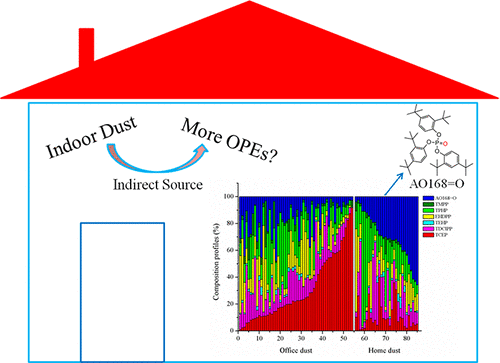当前位置:
X-MOL 学术
›
Environ. Sci. Technol.
›
论文详情
Our official English website, www.x-mol.net, welcomes your feedback! (Note: you will need to create a separate account there.)
Unexpectedly High Concentrations of a Newly Identified Organophosphate Ester, Tris(2,4-di-tert-butylphenyl) Phosphate, in Indoor Dust from Canada
Environmental Science & Technology ( IF 10.8 ) Pub Date : 2018-08-16 , DOI: 10.1021/acs.est.8b03061 Runzeng Liu 1 , Scott A Mabury 1
Environmental Science & Technology ( IF 10.8 ) Pub Date : 2018-08-16 , DOI: 10.1021/acs.est.8b03061 Runzeng Liu 1 , Scott A Mabury 1
Affiliation

|
Organophosphate esters (OPEs) represent a group of additives with significant levels of production and significant application to various household and industrial products. Given their potential adverse effects on human health, accurate analysis of novel OPEs in indoor dust is crucial. In this study, the novel tris(2,4-di-tert-butylphenyl) phosphate (AO168═O) and six well-known OPEs were investigated. The seven target OPEs were detected in 100% of the office and home dust samples, with ∑OPEs (sum of the OPE concentrations) ranging from 2.92 to 124 μg/g [geometric mean (GM) of 12.3 μg/g]. Surprisingly, the novel AO168═O (0.10–11.1 μg/g, GM of 1.97 μg/g) was among the highest-concentration congeners, contributing 1.36–65.5% to ∑OPEs (mean of 20.7%). AO168═O was the dominant congener in the home dust samples, indicating it is an important OPE congener overlooked previously. AO168═O was also detected in Standard Reference Material 2585 (indoor dust) at an elevated concentration of 10.9 μg/g, which was significantly higher than the concentrations of the other target OPEs (0.38–2.17 μg/g). Despite the high concentrations measured in this study, no industrial production or application could be identified for AO168═O. The precursor of AO168═O, tris(2,4-di-tert-butylphenyl) phosphite, was detected in 50% of the dust samples, with a GM concentration of 1.48 ng/g. This study demonstrates that human OPE exposure in indoor environments is greater than was previously reported. This is the first report of the occurrence of AO168═O, its precursor, and its hydrolysis products in the environment.
中文翻译:

来自加拿大的室内灰尘中新发现的有机磷酸酯三(2,4-二叔丁基苯基)磷酸酯的浓度出乎意料地高
有机磷酸酯 (OPE) 代表了一组具有显着生产水平并在各种家用和工业产品中具有重要应用的添加剂。鉴于它们对人类健康的潜在不利影响,准确分析室内灰尘中的新型 OPE 至关重要。在这项研究中,新的 tris(2,4-di- tert对磷酸-丁基苯基)(AO168=O)和六种众所周知的OPE进行了研究。在 100% 的办公室和家庭灰尘样本中检测到七种目标 OPE,∑OPE(OPE 浓度之和)范围为 2.92 至 124 μg/g [几何平均值 (GM) 为 12.3 μg/g]。令人惊讶的是,新的 AO168=O(0.10-11.1 μg/g,GM 为 1.97 μg/g)是浓度最高的同源物之一,对 ∑OPE 的贡献率为 1.36-65.5%(平均值为 20.7%)。AO168=O 是家庭尘埃样品中的主要同源物,表明它是以前被忽视的重要 OPE 同源物。在标准参考物质 2585(室内灰尘)中也检测到 AO168=O,浓度升高到 10.9 μg/g,显着高于其他目标 OPE 的浓度(0.38-2.17 μg/g)。尽管在这项研究中测量了高浓度,AO168=O 没有工业生产或应用。AO168=O的前体,tris(2,4-di-在 50% 的粉尘样品中检测到亚磷酸叔丁基苯基酯,GM 浓度为 1.48 ng/g。这项研究表明,人类在室内环境中的 OPE 暴露量比之前报道的要高。这是AO168=O、其前体及其水解产物在环境中发生的首次报道。
更新日期:2018-08-17
中文翻译:

来自加拿大的室内灰尘中新发现的有机磷酸酯三(2,4-二叔丁基苯基)磷酸酯的浓度出乎意料地高
有机磷酸酯 (OPE) 代表了一组具有显着生产水平并在各种家用和工业产品中具有重要应用的添加剂。鉴于它们对人类健康的潜在不利影响,准确分析室内灰尘中的新型 OPE 至关重要。在这项研究中,新的 tris(2,4-di- tert对磷酸-丁基苯基)(AO168=O)和六种众所周知的OPE进行了研究。在 100% 的办公室和家庭灰尘样本中检测到七种目标 OPE,∑OPE(OPE 浓度之和)范围为 2.92 至 124 μg/g [几何平均值 (GM) 为 12.3 μg/g]。令人惊讶的是,新的 AO168=O(0.10-11.1 μg/g,GM 为 1.97 μg/g)是浓度最高的同源物之一,对 ∑OPE 的贡献率为 1.36-65.5%(平均值为 20.7%)。AO168=O 是家庭尘埃样品中的主要同源物,表明它是以前被忽视的重要 OPE 同源物。在标准参考物质 2585(室内灰尘)中也检测到 AO168=O,浓度升高到 10.9 μg/g,显着高于其他目标 OPE 的浓度(0.38-2.17 μg/g)。尽管在这项研究中测量了高浓度,AO168=O 没有工业生产或应用。AO168=O的前体,tris(2,4-di-在 50% 的粉尘样品中检测到亚磷酸叔丁基苯基酯,GM 浓度为 1.48 ng/g。这项研究表明,人类在室内环境中的 OPE 暴露量比之前报道的要高。这是AO168=O、其前体及其水解产物在环境中发生的首次报道。








































 京公网安备 11010802027423号
京公网安备 11010802027423号